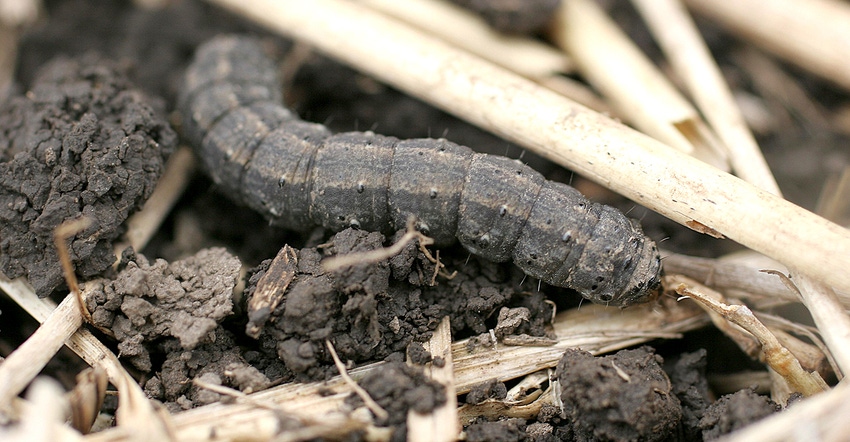March 16, 2018

Black cutworm is one of the first pests that is going try to take a bite out of your corn yield potential this spring.
Adam Varenhorst, South Dakota State University Extension field crops entomologist, and Patrick Wagner and Amanda Bachmann — also from SDSU — penned a primer on black cutworms recently.
First the good news: They report that there are several seed treatments, with the active ingredients clothianidin and thiamethoxam, labeled to reduce black cutworm populations.
There are also Bt corn hybrids labeled for black cutworm control, specifically hybrids that produce either Cry1F or Vip3A Bt toxins.
But the bad news: Scouting for black cutworm caterpillars is difficult. The caterpillars are nocturnal and hide during the day. Scouting revolves around finding corn plants with signs of caterpillar feeding either on the leaves or around the base of the stalk, or the presence of cut plants.
Scouting should begin during corn emergence (VE) and continue weekly until V5 leaf stage, they advise.
An insecticide treatment is recommended if more than 5% of corn plants are cut and any black cutworm caterpillars that are found are less than 1-inch long. If they are 1-inch longer or bigger, they’ve a done their damage. They are about to pupate and turn into moths.
Currently registered insecticides for management of black cutworm in corn are listed in the 2018 edition of the “South Dakota Pest Management Guide: Corn.” (http://igrow.org/up/resources/03-3041-2017.pdf)
In North Dakota, see the “North Dakota Field Crop Insect Management Guide.”
More tips
Some good things to know about black cutworms are:
• The first moths migrate from the south early in the spring and lay eggs in field debris. The larvae that hatch feed on the base of young corn plants. They will chew on wheat, several different vegetables and turf grasses.
• There are multiple generations of black cutworm per year, however only the first generation typically causes significant injury to corn because they are can feed around the stem completely.
• After the V5 stage of development, corn plants become big enough to tolerate black cutworm feeding.
Pest management guides online
Pest management guides for most of the major and small market crops grown in South Dakota and North Dakota are available online.
“These guides are completely updated and revised to provide South Dakotans with research-based recommendations for controlling weeds, insects and diseases," says Paul O. Johnson, SDSU Extension weed science coordinator.
The 2018 South Dakota Pest Management Guides include several new products, older products now sold under new names, and the corresponding changes made to labeling instructions such as rates for the chemicals, rotation restrictions, additive rates and products.
"Although much has changed, the prices for the products are similar to last year," he says.
Find the South Dakota Pest Management Guide.
In North Dakota, the Extension Service publishes three guides:
• Weeds
• Insects
• Diseases
You May Also Like




